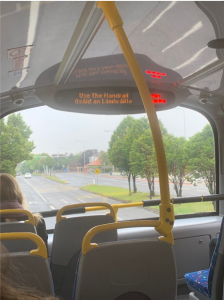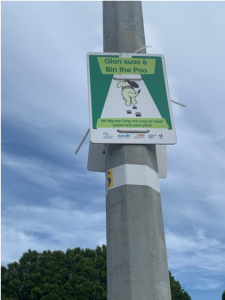This summer I am doing an internship in the city of Dublin and the more time I have spent in here, the more I have been able to understand its unique linguistic landscape. Coming to Ireland I though the only language spoken here was English however, as I begun to explore Dublin; began using its public transport; and visiting different parts of the city, I noticed that there was a less popular, traditional Irish Gaelic language. Irish is seen as the official national language of the country and was created by its original settlers (Pariona, 2016). However, English is the most spoken language; 97.5% speak English and 17% speak Irish (languageknowlede.eu). After examining the frequency of the 2 languages on public signs, where they were both spoken, and having a discussion about this with my Irish co-worker, I came to a conclusion on Ireland’s linguistic landscape. Unlike Leeman and Modan, I found that language revitalization and empowerment of the minority language is the goal in this case. Irish Gaelic is seen as a “valuable cultural element worthy of preservation” in Ireland, so its use is encouraged through putting it on public signs (Leeman and Modan, 2009, pg. 358).
As expressed by Leeman and Modan, the term ‘linguistic landscape’ is very complex. Most researchers see it as just ‘the language of public road signs advertising, billboards, street names etc., as defined by Landry and Bourhis. (Leeman and Modan, 2009). Contrastingly, Leeman and Modan expand the term by suggesting that it also concerns social and political histories; the economy at hand; and the environment as well. (Leeman and Modan, 2009, pg. 332-333). Another important thing they point out is that linguistic landscapes are subjective representations and not objective.
Given this, I began my task, of determining my subjective view of Ireland’s linguistic landscape. During my first few days in Dublin, I would explore the city mainly by walking and using taxis, and mostly go to the city centre area. Throughout this time, I thought that Dublin was a monolingual city. The only language I noticed being used was English, all the billboards and shops in the city centre were written only in English. I did hear other languages whilst walking around the city centre but languages like French and Russian, so I assumed the people speaking those were just tourists. My view of the city’s linguistic language changed however when I became better assimilated in the city.
I eventually started using public transport, mostly the bus, and visited the outskirts of Dublin as well as some surrounding cities. Doing so made me realize the use of Irish Gaelic more. On the buses I saw that for every stop, the name would be written and announced in English first, then Irish second. I then asked my co-worker about language in Ireland and was told more about Irish Gaelic, which she spoke fluently. After I heard her speak it, I knew what it sounded like and began to notice is more around town (but still not at the city centre however). I heard people speak Irish in the supermarket I do my grocery shopping at, and saw that public signs in the area I live are in both English and Irish. The Irish language is hardly used by private enterprises however. I haven’t seen a shop or business whose name is written in both English and Irish – just the public signs.
My co-worker then explained to me cultural importance of Irish Gaelic. The language is compulsory in school, even though most people don’t enjoy learning it since it is a hard language to grasp, the government wants to make sure it doesn’t die out. She also stated that it is spoken predominately in certain parts of Ireland. Because Dublin is one of the most multi-cultural, commercialized and urban cities in Dublin, you would not hear Irish spoken as much as you would in other parts of Ireland. So I came to the conclusion that the public signs and buses are written in Irish along with English to encourage people to speak it more.


(Photos showing public signs/transport in Ireland, using both English and Irish Gaelic)
Works Cited
Languages in Ireland. (n.d.).Retrieved from https://languageknowledge.eu/countries/ireland
Leeman, J., & Modan, G. (2009). Commodified language in Chinatown: A contextualized approach to linguistic landscape1. Journal of Sociolinguistics, 13(3), 332-362.
Pariona, A. (2016, November 03). What Languages Are Spoken In Ireland? Retrieved from https://www.worldatlas.com/articles/what-languages-are-spoken-in-ireland.html